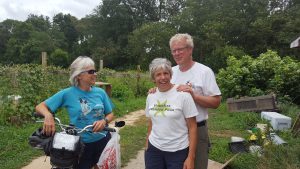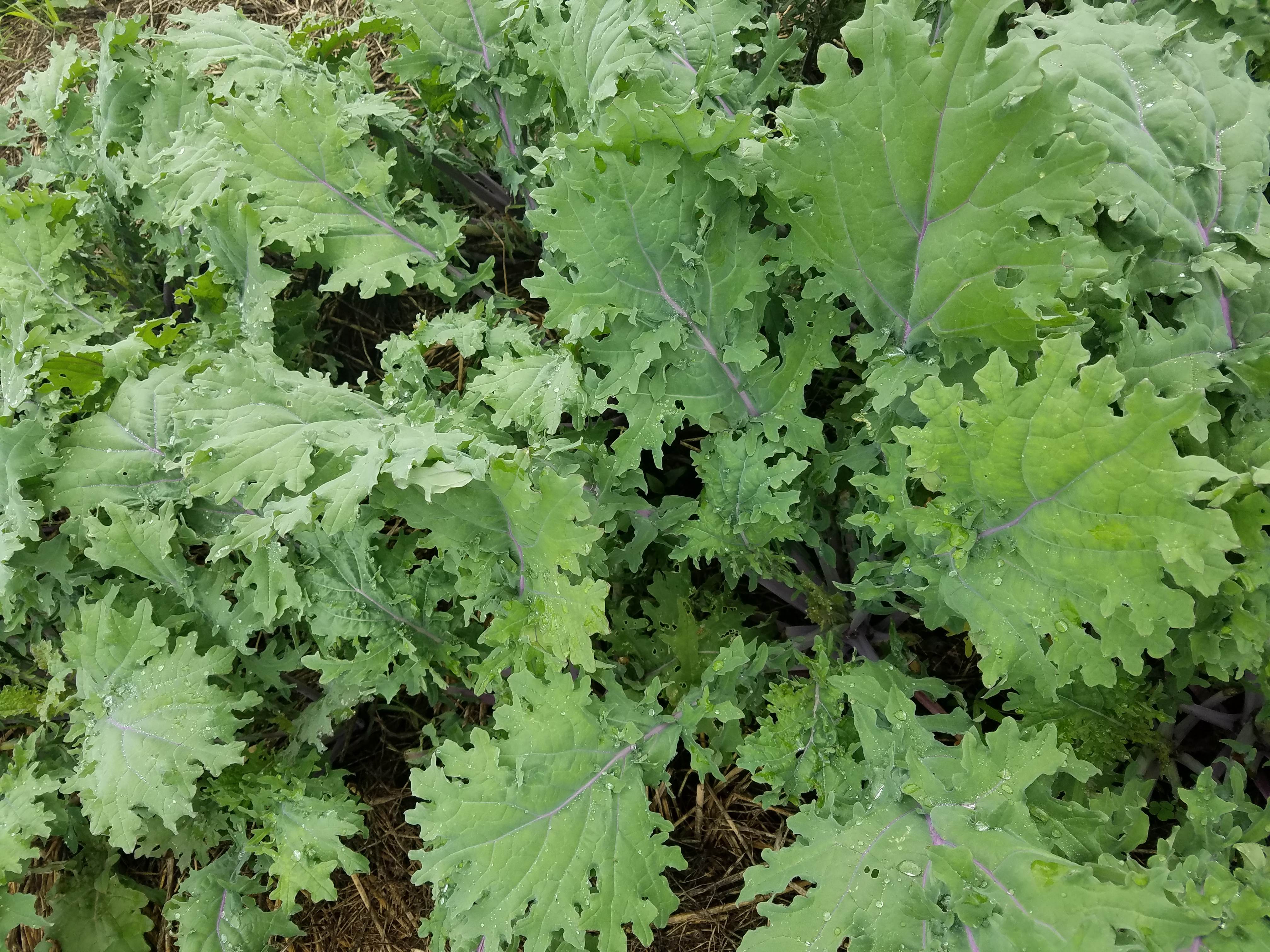As the sun breaks the sky, the farmers rise. Today is a pick day—a day where we harvest vegetables and fruits for CSA baskets and market. I’m usually rushing out the door, even though I live so close that the view out my bedroom window exposes the dirt on the white panes of the barn. As the crew arrives at the barn, we pay our morning dues to each other with a limp smile, except Cricket; he is usually jolly in the mornings for reasons unknown, but still a joy I aspire to feel early in the mornings.
Usually I begin by reordering the baskets and labeling them for our CSA customers. This takes some time because each week there is an oddly different pattern for the same customers. One day there will be a system we can pass onto the next Copper Cricketers.
Hours pass as some harvest and others package the vegetables. While picking, we weed the vegetables rows to maximize productivity. Nevertheless, the process includes moving efficiently through the vegetables, greens, and fruits and picking the ones that look edible. Sometimes the quality can vary because as workers, we can eat greens such as the kale that first belonged to a harlequin beetle; this type of hand-me-down food is better known as farmer food. Cricket and Carol are most generous to the customers and remind us that our standards are too low for customer quality.
Next, the vegetables and greens are brought into the barn to the packaging person. This is usually me. I have dominated the packaging role because at least one person should know what is going on to ensure consistency; otherwise, headless chickens might as well run the farm. The vegetables or greens are dumped gently into the sink to soak in cool water. Cricket once said that cold water does wonders in reviving vegetables, so I let them sit for a few minutes feeling like a hero watching the them come back to life. After the greens are reborn, I begin my monotonous work: open a bag, place a paper towel, add greens in the bag until the desired weight is reached. I have become annoyingly persistent with the weight, as I only allow a maximum of .1 oz. difference in weight between each bag. I do this about 200 more times. Usually an hour before noon we all decide to pick up our pace to make sure that all the swiss chard, cabbage, beans, potatoes, celery, radishes, and many more edibles are packaged and placed in a tetris-like manner inside the refrigerator. Ten minutes before noon, we become hungry fanatics tumbling around to ensure there is enough food for the baskets and the market. However, this is not even the most hectic part of the day. Luckily, Cricket and Carol feed their staff before the next step—they knew what they were doing.
After lunch, we pack the baskets. This means one person calls out who gets what in each basket according to their preferences, while another places the vegetables in the appropriate baskets. Meanwhile, some crewmembers peacefully arrange flowers in an extravagant bouquet for each basket. Carol comes in to check each basket and carefully displays each vegetable and positions the finishing touch—the flowers and a mist of water. As the baskets undergo beautification, they are loaded into the truck to be delivered to the customers. We wave our truck goodbye and breathe while looking at the mess in the barn.



 Thank you, thank you for being our reciprocal for that, and for all the wonderful volunteers who came through for us on our most bleak days. Our customer appreciation dinner in October was a great success! So much good, local food, shared among friends. My mouth is already watering for the next one!
Thank you, thank you for being our reciprocal for that, and for all the wonderful volunteers who came through for us on our most bleak days. Our customer appreciation dinner in October was a great success! So much good, local food, shared among friends. My mouth is already watering for the next one! Christmas. I for one enjoyed getting to know the woods a bit better while I scouted for the greenest boxwood and the most delectable holly. We hope you enjoyed the premier, and we felt it was rather a booming success. We hope that wreath production will become a staple of our business and hope we can adorn your doors in the coming winter.
Christmas. I for one enjoyed getting to know the woods a bit better while I scouted for the greenest boxwood and the most delectable holly. We hope you enjoyed the premier, and we felt it was rather a booming success. We hope that wreath production will become a staple of our business and hope we can adorn your doors in the coming winter.
 The last item I have to discuss is the erection of our hoop house. We did not foresee this unusually cold weather, and thus I went a little crazy in the greenhouse. We like to get a head-start with our spring crops by starting them early in the greenhouse and moving them into the field as soon as possible under row-cover. I made the crop plan this year, and call me ambitious, but it became abundantly clear that we had out-grown the
The last item I have to discuss is the erection of our hoop house. We did not foresee this unusually cold weather, and thus I went a little crazy in the greenhouse. We like to get a head-start with our spring crops by starting them early in the greenhouse and moving them into the field as soon as possible under row-cover. I made the crop plan this year, and call me ambitious, but it became abundantly clear that we had out-grown the  greenhouse attached to the barn (there are seeds growing out of every visible vertical and horizontal space, not to mention sprouting in plastic baggies. I’m pretty sure they will start climbing up the walls soon and you might find me at the bottom of a tangle of roots). Arthur and Carol had apparently seen this coming, and had plans in the works for building a hoop-house. We got the big steel hoops from a neighbor and loyal member, ordered some plastic, Cricket worked his magic in the wood-workshop, and voila! A hoop house! It is unheated, but has big doors on each end, to help with air-flow and temperature regulation. The idea is to move the sprouts out of the greenhouse at the first sign of true leaves, and into the hoop-house, where they will get used to the outside temperatures, and harden themselves before we plant them into the warm ground. This will allow us to grow more intensively in our cultivated area, only about 2 acres of which we use to produce for all of you! This is very exciting and I hope we can all reap the benefits in the coming season. Hopefully this will help us more fluidly move crops along from one season to the next.
greenhouse attached to the barn (there are seeds growing out of every visible vertical and horizontal space, not to mention sprouting in plastic baggies. I’m pretty sure they will start climbing up the walls soon and you might find me at the bottom of a tangle of roots). Arthur and Carol had apparently seen this coming, and had plans in the works for building a hoop-house. We got the big steel hoops from a neighbor and loyal member, ordered some plastic, Cricket worked his magic in the wood-workshop, and voila! A hoop house! It is unheated, but has big doors on each end, to help with air-flow and temperature regulation. The idea is to move the sprouts out of the greenhouse at the first sign of true leaves, and into the hoop-house, where they will get used to the outside temperatures, and harden themselves before we plant them into the warm ground. This will allow us to grow more intensively in our cultivated area, only about 2 acres of which we use to produce for all of you! This is very exciting and I hope we can all reap the benefits in the coming season. Hopefully this will help us more fluidly move crops along from one season to the next.

 People often ask me why I farm. Or perhaps more directly, why would I work in a profession that generates little respect because it almost never creates monetary wealth for its practitioners. It is not a trivial question. Carol and I spend a lot of time justifying our lifestyle to each other. The funny thing is, everyone who asks us this seems to have some sense that we are doing something incredibly positive. People thank us all the time for doing what we do. They regale us with stories about great meals, great times, and great memories connected with our humble vegetables. And usually, they express at least some desire to join us- “I would love to do what you do someday”. Right now, our farm works partly because we get so much “free” help from others. We have two wonderful women who are currently working on the farm one morning a week together. Ostensibly they are doing it to learn our techniques to apply to their own gardens. But I think they are enjoying getting their hands dirty“farming”. It helps to balance out some of the rest of life that is so disconnected today to our natural world. There seems to be something positive for the human spirit working at a diversified farm. The image is so powerful it is used everywhere in food marketing – ad campaigns often start with a beautiful morning sunrise, a rooster crowing in the background, and misty fields and woods with grass fed cows or sheep, and nature in abundance all around. What is fascinating for me is that most of the time, the products being sold are a long way from the reality of that beautiful farm. Most farming operations are not pleasant to see or visit. “Modern” farms are industrial operations scaled up to a mind boggling size. They do not feed the soul the way a smaller diversified farm seems to. A big part of why we farm is because it feels right. It is beautiful. It is great exercise. But more than these, it is healthful to live life simply in nature’s seasonal rhythm. It is spring now and we are planting seeds and nurturing baby plants. In a few weeks, we will start to plant outside and begin building for the first harvests in April or May. Our activities mirror Nature with her gradually building crescendo of birds, insects, frogs, and plant life waking up after the winter quiet. It is a wonderful pattern that is central to our motivation to work on our small farm.
People often ask me why I farm. Or perhaps more directly, why would I work in a profession that generates little respect because it almost never creates monetary wealth for its practitioners. It is not a trivial question. Carol and I spend a lot of time justifying our lifestyle to each other. The funny thing is, everyone who asks us this seems to have some sense that we are doing something incredibly positive. People thank us all the time for doing what we do. They regale us with stories about great meals, great times, and great memories connected with our humble vegetables. And usually, they express at least some desire to join us- “I would love to do what you do someday”. Right now, our farm works partly because we get so much “free” help from others. We have two wonderful women who are currently working on the farm one morning a week together. Ostensibly they are doing it to learn our techniques to apply to their own gardens. But I think they are enjoying getting their hands dirty“farming”. It helps to balance out some of the rest of life that is so disconnected today to our natural world. There seems to be something positive for the human spirit working at a diversified farm. The image is so powerful it is used everywhere in food marketing – ad campaigns often start with a beautiful morning sunrise, a rooster crowing in the background, and misty fields and woods with grass fed cows or sheep, and nature in abundance all around. What is fascinating for me is that most of the time, the products being sold are a long way from the reality of that beautiful farm. Most farming operations are not pleasant to see or visit. “Modern” farms are industrial operations scaled up to a mind boggling size. They do not feed the soul the way a smaller diversified farm seems to. A big part of why we farm is because it feels right. It is beautiful. It is great exercise. But more than these, it is healthful to live life simply in nature’s seasonal rhythm. It is spring now and we are planting seeds and nurturing baby plants. In a few weeks, we will start to plant outside and begin building for the first harvests in April or May. Our activities mirror Nature with her gradually building crescendo of birds, insects, frogs, and plant life waking up after the winter quiet. It is a wonderful pattern that is central to our motivation to work on our small farm.



